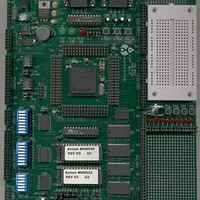MPC555CME Freescale Semiconductor, MPC555CME Datasheet - Page 882

MPC555CME
Manufacturer Part Number
MPC555CME
Description
KIT EVALUATION FOR MPC555
Manufacturer
Freescale Semiconductor
Type
Microcontrollerr
Datasheet
1.MPC555CME.pdf
(966 pages)
Specifications of MPC555CME
Contents
Module Board, Installation Guide, Power Supply, Cable, Software and more
Processor To Be Evaluated
MPC555
Data Bus Width
32 bit
Interface Type
RS-232
For Use With/related Products
MPC555
Lead Free Status / RoHS Status
Contains lead / RoHS non-compliant
- Current page: 882 of 966
- Download datasheet (13Mb)
MPC555 / MPC556
USER’S MANUAL
An estimation of the chip junction temperature, T
equation:
where:
The junction to ambient thermal resistance is an industry standard value which pro-
vides a quick and easy estimation of thermal performance. Unfortunately, the answer
is only an estimate; test cases have demonstrated that errors of a factor of two are pos-
sible. As a result, more detailed thermal characterization is supplied.
Historically, the thermal resistance has frequently been expressed as the sum of a
junction to case thermal resistance and a case to ambient thermal resistance:
where:
R
thermal environment to change the case to ambient thermal resistance, R
stance, the user can change the air flow around the device, add a heat sink, change
the mounting arrangement on printed circuit board, or change the thermal dissipation
on the printed circuit board surrounding the device. This description is most useful for
ceramic packages with heat sinks where some 90% of the heat flow is through the
case to the heat sink to ambient. For most packages, a better model is required.
The simplest thermal model of a package which has demonstrated reasonable accu-
racy (about 20%) is a two resistor model consisting of a junction to board and a junc-
tion to case thermal resistance. The junction to case covers the situation where a heat
sink will be used or where a substantial amount of heat is dissipated from the top of
the package. The junction to board thermal resistance describes the thermal perfor-
mance when most of the heat is conducted to the printed circuit board. It has been ob-
served that the thermal performance of most plastic packages and especially PBGA
packages is strongly dependent on the board. temperature.
If the board temperature is known, an estimate of the junction temperature in the en-
vironment can be made using the following equation:
θJC
T
R
P
R
R
R
is device related and cannot be influenced by the user. The user controls the
A
D
θJA
θJA
θJC
θJA
= ambient temperature (°C)
= power dissipation in package
= package junction to ambient resistance (°C/W)
= junction to ambient thermal resistance (°C/W)
= case to ambient thermal resistance (°C/W)
= junction to case thermal resistance (°C/W)
ELECTRICAL CHARACTERISTICS
Rev. 15 October 2000
T
R
J
θJA
= T
A
= R
+ (R
θJC
θJA
+ R
x P
J
θCA
, in °C can be obtained from the
D
)
θCA
MOTOROLA
. For in-
G-4
Related parts for MPC555CME
Image
Part Number
Description
Manufacturer
Datasheet
Request
R

Part Number:
Description:
MPC555 Interrupts
Manufacturer:
Freescale Semiconductor / Motorola
Datasheet:
Part Number:
Description:
Manufacturer:
Freescale Semiconductor, Inc
Datasheet:
Part Number:
Description:
Manufacturer:
Freescale Semiconductor, Inc
Datasheet:
Part Number:
Description:
Manufacturer:
Freescale Semiconductor, Inc
Datasheet:
Part Number:
Description:
Manufacturer:
Freescale Semiconductor, Inc
Datasheet:
Part Number:
Description:
Manufacturer:
Freescale Semiconductor, Inc
Datasheet:
Part Number:
Description:
Manufacturer:
Freescale Semiconductor, Inc
Datasheet:
Part Number:
Description:
Manufacturer:
Freescale Semiconductor, Inc
Datasheet:
Part Number:
Description:
Manufacturer:
Freescale Semiconductor, Inc
Datasheet:
Part Number:
Description:
Manufacturer:
Freescale Semiconductor, Inc
Datasheet:
Part Number:
Description:
Manufacturer:
Freescale Semiconductor, Inc
Datasheet:
Part Number:
Description:
Manufacturer:
Freescale Semiconductor, Inc
Datasheet:
Part Number:
Description:
Manufacturer:
Freescale Semiconductor, Inc
Datasheet:
Part Number:
Description:
Manufacturer:
Freescale Semiconductor, Inc
Datasheet:
Part Number:
Description:
Manufacturer:
Freescale Semiconductor, Inc
Datasheet:










